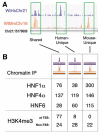Species-specific transcription in mice carrying human chromosome 21
- PMID: 18787134
- PMCID: PMC3717767
- DOI: 10.1126/science.1160930
Species-specific transcription in mice carrying human chromosome 21
Abstract
Homologous sets of transcription factors direct conserved tissue-specific gene expression, yet transcription factor-binding events diverge rapidly between closely related species. We used hepatocytes from an aneuploid mouse strain carrying human chromosome 21 to determine, on a chromosomal scale, whether interspecies differences in transcriptional regulation are primarily directed by human genetic sequence or mouse nuclear environment. Virtually all transcription factor-binding locations, landmarks of transcription initiation, and the resulting gene expression observed in human hepatocytes were recapitulated across the entire human chromosome 21 in the mouse hepatocyte nucleus. Thus, in homologous tissues, genetic sequence is largely responsible for directing transcriptional programs; interspecies differences in epigenetic machinery, cellular environment, and transcription factors themselves play secondary roles.
Figures




Comment in
-
Genetics. It's the sequence, stupid!Science. 2008 Oct 17;322(5900):380-1. doi: 10.1126/science.1165664. Science. 2008. PMID: 18927376 Free PMC article. No abstract available.
Similar articles
-
Genetics. It's the sequence, stupid!Science. 2008 Oct 17;322(5900):380-1. doi: 10.1126/science.1165664. Science. 2008. PMID: 18927376 Free PMC article. No abstract available.
-
Mouse models of Down syndrome: how useful can they be? Comparison of the gene content of human chromosome 21 with orthologous mouse genomic regions.Gene. 2003 Oct 30;318:137-47. doi: 10.1016/s0378-1119(03)00769-8. Gene. 2003. PMID: 14585506
-
Latent regulatory potential of human-specific repetitive elements.Mol Cell. 2013 Jan 24;49(2):262-72. doi: 10.1016/j.molcel.2012.11.013. Epub 2012 Dec 13. Mol Cell. 2013. PMID: 23246434 Free PMC article.
-
The sequence of human chromosome 21 and implications for research into Down syndrome.Genome Biol. 2000;1(2):REVIEWS0002. doi: 10.1186/gb-2000-1-2-reviews0002. Epub 2000 Aug 4. Genome Biol. 2000. PMID: 11178230 Free PMC article. Review.
-
The transcriptional regulatory code of eukaryotic cells--insights from genome-wide analysis of chromatin organization and transcription factor binding.Curr Opin Cell Biol. 2006 Jun;18(3):291-8. doi: 10.1016/j.ceb.2006.04.002. Epub 2006 May 2. Curr Opin Cell Biol. 2006. PMID: 16647254 Review.
Cited by
-
Human but not mouse adipogenesis is critically dependent on LMO3.Cell Metab. 2013 Jul 2;18(1):62-74. doi: 10.1016/j.cmet.2013.05.020. Cell Metab. 2013. PMID: 23823477 Free PMC article.
-
A functional selection model explains evolutionary robustness despite plasticity in regulatory networks.Mol Syst Biol. 2012;8:619. doi: 10.1038/msb.2012.50. Mol Syst Biol. 2012. PMID: 23089682 Free PMC article.
-
Cistrome plasticity and mechanisms of cistrome reprogramming.Cell Cycle. 2012 Sep 1;11(17):3199-210. doi: 10.4161/cc.21281. Epub 2012 Aug 16. Cell Cycle. 2012. PMID: 22895178 Free PMC article. Review.
-
Haplotype-specific assembly of shattered chromosomes in esophageal adenocarcinomas.Cell Genom. 2024 Feb 14;4(2):100484. doi: 10.1016/j.xgen.2023.100484. Epub 2024 Jan 16. Cell Genom. 2024. PMID: 38232733 Free PMC article.
-
Multiplexed massively parallel SELEX for characterization of human transcription factor binding specificities.Genome Res. 2010 Jun;20(6):861-73. doi: 10.1101/gr.100552.109. Epub 2010 Apr 8. Genome Res. 2010. PMID: 20378718 Free PMC article.
References
Publication types
MeSH terms
Substances
Grants and funding
LinkOut - more resources
Full Text Sources
Other Literature Sources

